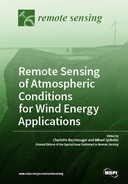Explore

Remote Sensing of Atmospheric Conditions for Wind Energy Applications
Charlotte Hasager and Mikael Sjöholm
2019
0 Ungluers have
Faved this Work
Login to Fave
This Special Issue “Atmospheric Conditions for Wind Energy Applications” hosts papers on aspects of remote sensing for atmospheric conditions for wind energy applications. Wind lidar technology is presented from a theoretical view on the coherent focused Doppler lidar principles. Furthermore, wind lidar for applied use for wind turbine control, wind farm wake, and gust characterizations is presented, as well as methods to reduce uncertainty when using lidar in complex terrain. Wind lidar observations are used to validate numerical model results. Wind Doppler lidar mounted on aircraft used for observing winds in hurricane conditions and Doppler radar on the ground used for very short-term wind forecasting are presented. For the offshore environment, floating lidar data processing is presented as well as an experiment with wind-profiling lidar on a ferry for model validation. Assessments of wind resources in the coastal zone using wind-profiling lidar and global wind maps using satellite data are presented..
This book is included in DOAB.
Why read this book? Have your say.
You must be logged in to comment.
Rights Information
Are you the author or publisher of this work? If so, you can claim it as yours by registering as an Unglue.it rights holder.Downloads
This work has been downloaded 299 times via unglue.it ebook links.
- 131 - pdf (CC BY-NC-ND) at Unglue.it.
Keywords
- Aerosol
- ASCAT
- atmospheric boundary layer
- coastal wind measurement
- coherent Doppler lidar
- complex flow
- complex terrain
- Control
- cross-correlation
- detached eddy simulation
- detecting and tracking
- Doppler
- Doppler wind lidar
- Doppler lidar
- Doppler radar
- Doppler Wind Lidar
- empirical equation
- fetch effect
- field experiments
- five-minute ahead wind power forecasting
- Floating Lidar System (FLS)
- Floating Lidar System (FLS), wind resource assessment
- global ocean
- gust prediction
- Hazaki Oceanographical Research Station
- IEA Wind Task 32
- impact prediction
- large-eddy simulations
- LiDAR
- lidar-assisted control (LAC)
- mesoscale
- motion estimation
- NeoWins
- NWP model
- offshore
- offshore wind speed forecasting
- optical flow
- power performance testing
- probabilistic forecasting
- QuikSCAT
- range gate length
- Remote sensing
- remote sensing forecasting
- resource assessment
- single-particle
- Tropical Cyclones
- Turbulence
- turbulence intensity
- VAD
- variational analysis
- velocity-azimuth-display algorithm
- velocity-azimuth-display algorithm
- vertical Light Detection and Ranging
- virtual lidar
- wake
- wake modeling
- Wind
- wind atlas
- Wind energy
- wind energy resources
- wind farm
- wind gusts
- wind lidar
- wind resource assessment
- wind sensing
- wind structure
- wind turbine
- wind turbine controls
- wind turbine wake
- WindSAT
Links
DOI: 10.3390/books978-3-03897-943-2Editions


